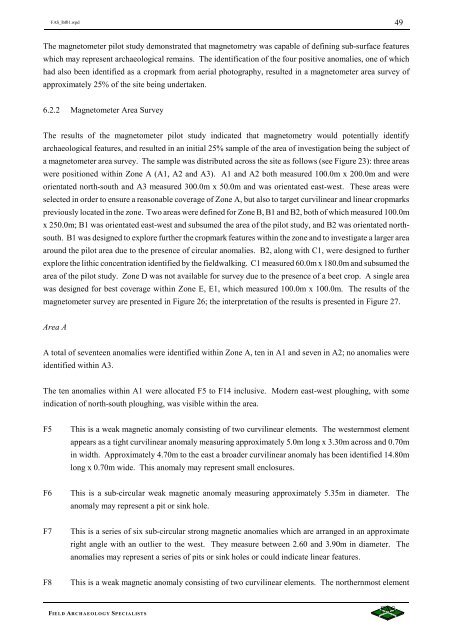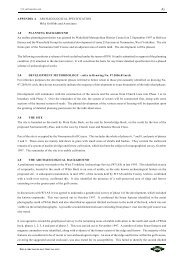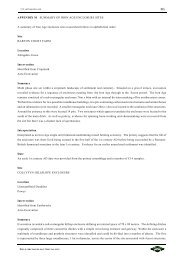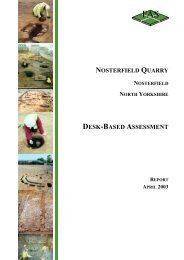ARCHAEOLOGICAL EVALUATION - Mike Griffiths and Associates
ARCHAEOLOGICAL EVALUATION - Mike Griffiths and Associates
ARCHAEOLOGICAL EVALUATION - Mike Griffiths and Associates
Create successful ePaper yourself
Turn your PDF publications into a flip-book with our unique Google optimized e-Paper software.
FAS_lbf01.wpd 49<br />
The magnetometer pilot study demonstrated that magnetometry was capable of defining sub-surface features<br />
which may represent archaeological remains. The identification of the four positive anomalies, one of which<br />
had also been identified as a cropmark from aerial photography, resulted in a magnetometer area survey of<br />
approximately 25% of the site being undertaken.<br />
6.2.2 Magnetometer Area Survey<br />
The results of the magnetometer pilot study indicated that magnetometry would potentially identify<br />
archaeological features, <strong>and</strong> resulted in an initial 25% sample of the area of investigation being the subject of<br />
a magnetometer area survey. The sample was distributed across the site as follows (see Figure 23): three areas<br />
were positioned within Zone A (A1, A2 <strong>and</strong> A3). A1 <strong>and</strong> A2 both measured 100.0m x 200.0m <strong>and</strong> were<br />
orientated north-south <strong>and</strong> A3 measured 300.0m x 50.0m <strong>and</strong> was orientated east-west. These areas were<br />
selected in order to ensure a reasonable coverage of Zone A, but also to target curvilinear <strong>and</strong> linear cropmarks<br />
previously located in the zone. Two areas were defined for Zone B, B1 <strong>and</strong> B2, both of which measured 100.0m<br />
x 250.0m; B1 was orientated east-west <strong>and</strong> subsumed the area of the pilot study, <strong>and</strong> B2 was orientated northsouth.<br />
B1 was designed to explore further the cropmark features within the zone <strong>and</strong> to investigate a larger area<br />
around the pilot area due to the presence of circular anomalies. B2, along with C1, were designed to further<br />
explore the lithic concentration identified by the fieldwalking. C1 measured 60.0m x 180.0m <strong>and</strong> subsumed the<br />
area of the pilot study. Zone D was not available for survey due to the presence of a beet crop. A single area<br />
was designed for best coverage within Zone E, E1, which measured 100.0m x 100.0m. The results of the<br />
magnetometer survey are presented in Figure 26; the interpretation of the results is presented in Figure 27.<br />
Area A<br />
A total of seventeen anomalies were identified within Zone A, ten in A1 <strong>and</strong> seven in A2; no anomalies were<br />
identified within A3.<br />
The ten anomalies within A1 were allocated F5 to F14 inclusive. Modern east-west ploughing, with some<br />
indication of north-south ploughing, was visible within the area.<br />
F5<br />
This is a weak magnetic anomaly consisting of two curvilinear elements. The westernmost element<br />
appears as a tight curvilinear anomaly measuring approximately 5.0m long x 3.30m across <strong>and</strong> 0.70m<br />
in width. Approximately 4.70m to the east a broader curvilinear anomaly has been identified 14.80m<br />
long x 0.70m wide. This anomaly may represent small enclosures.<br />
F6<br />
This is a sub-circular weak magnetic anomaly measuring approximately 5.35m in diameter. The<br />
anomaly may represent a pit or sink hole.<br />
F7<br />
This is a series of six sub-circular strong magnetic anomalies which are arranged in an approximate<br />
right angle with an outlier to the west. They measure between 2.60 <strong>and</strong> 3.90m in diameter. The<br />
anomalies may represent a series of pits or sink holes or could indicate linear features.<br />
F8<br />
This is a weak magnetic anomaly consisting of two curvilinear elements. The northernmost element<br />
FIELD ARCHAEOLOGY SPECIALISTS







